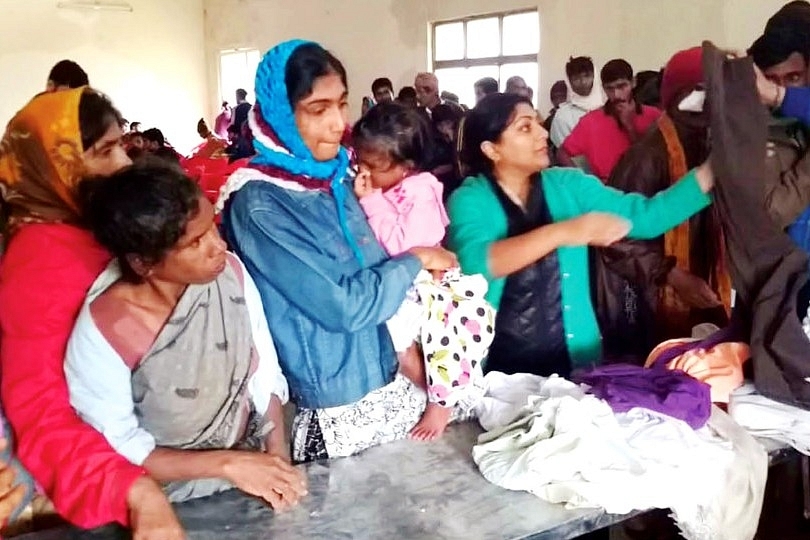
Kodagu Floods: Relief Centres Battle Sanitation, Medical Challenges
Relief centres in Kodagu that are providing food and shelter to thousands of flood victims are finding it difficult to meet sanitation and medical needs. Every centre has just one or two doctors, while the number of patients is in hundreds.
Over 9,000 displaced and homeless people have been sheltered at more than 600 Ganji Kendras (gruel centres) established at various parts of Kodagu district, especially in Madikeri and Somwarpet taluks that have witnessed the worst floods in the district so far.
The Ganji Kendras have been established in towns, village and hobli-levels and local youths, along with district administration, have been handling the rescue and food supply operations. People who are saved by rescue teams are being shifted to Ganji Kendras in trucks and buses where they are being sheltered according to available space.
Schools, colleges, government offices, community halls and even home stays have been converted to Ganji Kendras to provide succour to the people. Many home stay owners have voluntarily come forward to accommodate displaced victims by providing them food and comfortable shelter.
Sanitation and Medical Challenge
The daunting task at Ganji Kendras is medical and toilet facilities. The toilets of government offices, community halls and schools are limited in number and it is beyond their capacity to handle hundreds of users. They are making fervent appeals to the district authorities to get bio-toilets as there is a possibility of diseases being spread. During his visit to the Ganji Kendras, Chief Minister H D Kumaraswamy had assured people that truckloads of bio-toilets are being despatched from Bengaluru.
Apart from sanitation challenge, another major problem faced at Ganji Kendras is medical facilities. At each Ganji Kendra one or two doctors have been deputed and they are expected to treat hundreds of patients who are suffering from diabetes, foot infection and hyper tension.
“We have children as young as three months, pregnant women, elderly persons and even physically challenged people. It is hard to give full medical attention to all. Still we are trying our best despite shortage of doctors,” Dr Srinivas who was managing patients at a relief centre told Star Of Mysore.
Packed with people
Almost all Ganji Kendras are packed with people. Rice and vegetables that are being supplied by donors and district administration, are being cooked at the Ganji Kendras and are supplied to people in paper plates. Most of the food prepared is in gruel form that is easy to digest for children and the elderly. Apart from food, local residents and the youth organisations are lending a helping hand and are supplying footwear, clothes, soaps, sanitary pads, bed sheets and other essentials that have been donated from cities like Mysuru and Bengaluru.
Rain Relents
After being battered by torrential rain since over a week, the weather brought some reprieve for the people yesterday and today with flood waters receding which helped rescue operations gather pace. However, relief and rescue operations have not yet gained full momentum in Madikeri as interior roads are yet to be cleared of mud and rubble deposited due to landslides. Nearly 2,000 personnel from the Army, Navy, National and State Disaster Response Force, and Quick Response Team of Karnataka Civil Defence and Fire Department have reached out to people stranded in remote hilly areas where scores are still stuck.
Thousands of hectares of coffee plantations in Makkandur, Haleri, Galibeedu, Hattihole, First and Second Monnangeri, Jodupala, Thantipaala, Meghathalu and Mukkodlu, have been washed away. At least 20 villages have been completely destroyed in the rain and floods.
People in tears
Poignant scenes were witnessed in the Ganji Kendras with people literally in tears for their plight. Almost all of them have lost their homes at Garwale, Soorlabbi, Hachchinadu, Jodupala, Shirangala, Mandalapatti, Hattihole, Kaluru, Galibeedu, First and Second Monnangeri and Muvathoklu, Katakeri, Makkandur, Yemmethaalu and Meghathalu, and Hattihole. Most of them are small land holders and come from poor-income families.
In Madikeri town, some of the Ganji Kendras have been established at Mythri Police Hall, Brahmins Kalyana Mantap, General Thimmayya School, Ambedkar Layout Community Hall, AV School, Chamber of Commerce Hall. In Suntikoppa, the centres have been established at St. Antony’s Church, St. Mary’s School, Government School and Gowda Samaja. In Somwarpet and Kushalnagar, relief centres have been set up at Gowda Samaja, Kodava Samaja and Vasavi Hall. In Napoklu, people have been sheltered at Kunjila School.
Nowhere to go
Many people at the Ganji Kendras expressed fears about their future and were seen worrying over the condition of their houses and farmlands. “Our family owns one acre of land in First Monnangeri and our house and property has been washed away. We have nowhere to go even after the rain stops,” said Savithri. She added that the livestock that the family depended on have been left back at their village to fend for themselves. The situation is worse in Madapura where many villages have been washed away. The Hattihole River resembles a sea with water all over. Kotebetta and parts of Pushpagiri hills face the threat of collapse. More than 3,000 people have been shifted from the villages and have been accommodated at Ganji Kendras.
“It is okay now, as we are staying in a friend’s home stay. But we are worried about our future as nothing is left back at our village. Hillocks have collapsed and our village at Hachchinadu looks like a huge mound of red and soggy mud,” said Somesh, a villager.
This article was originally published on Star of Mysore and has been republished here with permission.